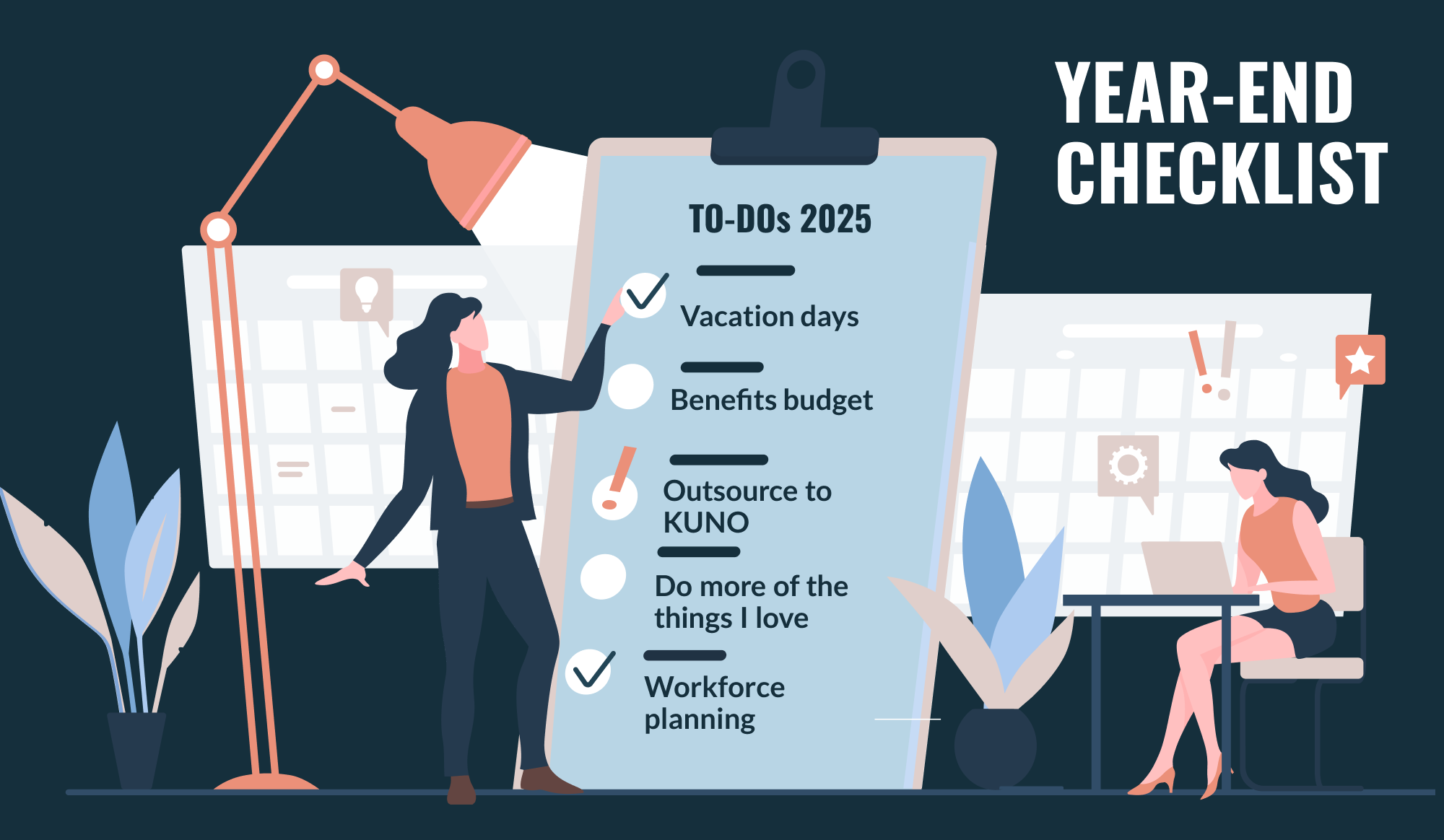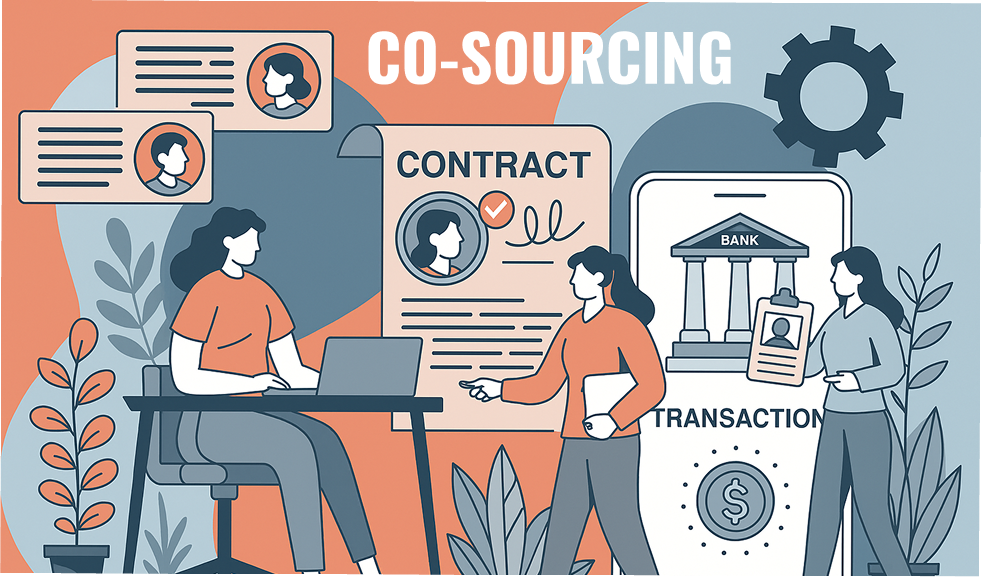Year-End Sprint in HR & Payroll – What Matters Most for 2025
As the year draws to a close, the HR and payroll departments enter one of their busiest phases. While many teams are finalizing projects or preparing for holidays, HR & Payroll are focused on reviewing data, meeting deadlines, updating systems, planning budgets, and setting the course for the upcoming year.
Working with structure now not only ensures a smooth year-end but also lays the foundation for a more strategic and efficient 2026. This article highlights key topics to review — including deadlines, current thresholds, practical examples, and strategic insights.
1. Planning Bonuses and Special Payments on Time
December is traditionally the month for bonuses and special payments — from annual bonuses and holiday pay to inflation compensation payments. These should be clearly defined and recorded in the payroll system before the end of the year.
The cash-flow principle is key: payments that employees receive for the year 2025 must also actually be paid out in 2025 in order to be attributed correctly for tax purposes. If the payment is made in January, the accrual principle must be applied in January of the following year to ensure correct tax treatment.
Practical example:
A bonus payout is postponed to January 2026 to preserve liquidity. However, this often causes confusion among employees and may lead to a higher tax burden if the payment is attributed to the following year under the cash-flow principle, rather than to the year in which the entitlement was earned under the accrual principle.
Early coordination between Finance and Payroll, combined with clear communication in advance, helps avoid these situations.
Quick check:
- Identify all bonus and special payments
- Coordinate payout dates with Finance and Payroll
- Inform employees transparently about timing and amounts
From a strategic perspective, it’s advisable to integrate bonus mechanisms into the HR budget and benefits planning for 2026 (see point 8) to ensure long-term consistency and transparency.
2. Reviewing Outstanding Vacation Days and Carryover Rules
Vacation balances are one of those topics that often only come to light at the beginning of the new year. In Germany, a distinction is made between the statutory minimum vacation, which generally must be taken by December 31, and any additional contractual vacation. Carrying over statutory vacation into the following year is only permitted in exceptional cases – for example, due to operational reasons, illness, or maternity protection – and must then be used by March 31 at the latest.
Regardless of the company’s internal policy, it’s worth reviewing vacation balances in December. The more unused vacation days are carried over into the new year, the higher the vacation provisions will be in the financial accounting. A timely review helps avoid unnecessary provisions and ensures alignment across HR, Payroll, and Finance.
Practical example:
In January, it becomes clear that significantly more unused vacation days need to be carried over than expected. This leads to extra coordination between HR, Payroll, and Finance, as well as a correspondingly higher vacation provision in the financial accounting. Such unplanned provisions can affect the annual financial result – a timely review in December helps avoid surprises and creates financial transparency.
Tip: Pull a vacation report from the HR system now, coordinate with managers, and inform employees about remaining days. At the same time, kick off the vacation planning for Q1 2026 so coverage can be planned early.
Pro tip: Set a reminder before March 31, 2026 to check which unused vacation days have actually been used. This allows you to inform employees in time that any remaining days will expire after this date – preventing misunderstandings and unnecessary follow-up questions.
3. Reviewing Tax-Free and Flat-Taxed Benefits Before Year-End
As part of year-end closing, companies should not only check regular payroll items but also tax-relevant additional benefits. These include tax-free allowances (e.g., for energy, commuting, or meals) as well as flat-taxed benefits, such as vouchers, gifts, or team events.
These benefits must be accurately recorded in the payroll system by year-end and, if applicable, reported to the tax advisor to ensure proper allocation in the annual accounts. In Germany, such benefits may fall under flat-rate taxation (§ 37b German Income Tax Act) if they exceed certain limits.
Organizations handling payroll internally or via external providers should pay particular attention here — retroactive corrections in the new year are time-consuming but can easily be avoided through early coordination.
Conclusion: Reviewing all tax-free and flat-taxed benefits at the end of the year improves transparency, minimizes post-year adjustments, and helps determine which benefits to maintain or optimize in 2026.
4. Social Security and Tax Thresholds for 2026
Starting January 1, 2026, new contribution thresholds apply to Germany’s statutory social security system. These are particularly relevant for employees with higher salaries and affect payroll calculations nationwide.
- Contribution assessment ceiling for health and long-term care insurance: €69,750 per year or €5,812.50 per month
- Contribution assessment ceiling for pension and unemployment insurance: €101,400 per year or €8,450 per month
Companies employing staff across multiple German regions should ensure both values are configured in their payroll systems. For remote or hybrid teams, it’s essential that the employee’s actual place of employment is correctly recorded, as this determines which regional threshold applies.
Employees with earnings near these limits should be proactively informed, as their contributions may slightly change — this transparency helps prevent confusion in January.
5. Reviewing Changes to Mini Jobs and Mid-Range Jobs
At the turn of the year 2026, several key parameters for marginal employment (Minijobs) will change. The statutory minimum wage will rise to €13.90 per hour. As a result, the earnings limit for Minijobs is expected to increase to €603 per month.
Companies should review whether existing Minijob contracts still fit these new conditions – especially if working hours are fixed in the contract. It may be necessary to adjust agreements or reassess staffing models, for example for temporary staff, support roles or project-based work.
With the higher Minijob threshold, the entry point into the Midijob range also shifts upward. This means that employment relationships previously classified as Midijobs may fall back into the Minijob category from 2026 onwards – with different reporting requirements and contribution rules.
Example from practice: A company discovers that, due to the increased minimum wage and higher earnings limit, several employees will move into the Minijob category. By reviewing and adjusting contracts in advance, the transition can be implemented cleanly and later corrections can be avoided.
Conclusion: Reviewing contracts, checking scheduled working hours and updating payroll systems are essential now. Companies that complete these steps in December can start 2026 with correct classifications and without time-consuming adjustments.
6. Cleaning Up HR and Payroll Systems
Year-end is the perfect moment to tidy up your systems — not as a theoretical audit, but as a practical clean-up. Over the year, HR Information Management Systems and payroll databases often accumulate incomplete or outdated records.
Now is the time to check:
- Are all relevant employee details complete and up to date?
- Are there information fields or sections rarely used that can be simplified or removed for the new year?
- Should internal structures or data categories be updated to make systems leaner and more efficient?
It’s also worth reviewing data retention and deletion policies: Which personal records must be deleted, and which must be archived for compliance reasons? Regular reviews prevent unnecessary data storage, ensure compliance with data protection laws (e.g., GDPR), and reduce long-term storage and admin costs.
Conclusion: This clean-up creates order, clarity, and data security. It saves time in the coming year and ensures HR and Payroll start 2026 with accurate and reliable data — a small investment with a big impact.
7. Preparing for the Pay Transparency Act and 2026 Reporting
Companies with more than 50 employees should begin preparing for the requirements of Germany’s Pay Transparency Act (Entgelttransparenzgesetz). Its goal is to ensure equal pay for work of equal value — and from 2026, many organizations will be required to provide corresponding documentation or reports.
Now is the time to:
- Review pay, function, and qualification data
- Define clear reporting processes
- Align responsibilities between HR, Finance, and Legal
This effort pays off twice: a solid data foundation not only simplifies reporting but also strengthens transparency toward employees.
Note: The Pay Transparency Act will be further detailed over the coming months and will bring new obligations for many companies. In one of our upcoming blog posts, we’ll explore this topic in depth — including the key legal updates, compliance requirements, and practical recommendations for HR and payroll teams.
To make sure you don’t miss this article, sign up for our KUNO newsletter to receive new updates and insights directly via email.
Conclusion: Plan early rather than catching up later — building structures now saves time, reduces risk, and builds trust.
8. HR Budget and Benefits Planning for 2026
To start the new year with structure, HR budget planning should happen now, not in spring. HR and Payroll are closely tied to Finance — investments in people, learning, and engagement only make an impact if they’re prepared in advance.
The planning process should cover:
- Base pay and variable compensation, such as bonuses and performance-based pay
- Learning and development budgets (e.g., for training programs, mentoring, or learning platforms)
- Onboarding and software costs, which often rise as teams grow
- Practical, everyday benefits, such as meal subsidies, anniversary bonuses, or small recognition awards
Recurring costs like recruiting platforms, licenses, and coaching services should also be realistically evaluated. Short-term decisions, such as introducing new benefits or training programs “on impulse,” often lead to budget overruns or underuse.
Practical example: During the year, a decision is made to introduce a training budget without allocating funds in advance. Since no budget was reserved, the initiative can only be implemented the following year. Early alignment between HR and management ensures such programs can be realized and effectively used.
Conclusion: Proactive budgeting creates financial clarity and decision-making confidence. It’s the foundation for realistic resources and clear priorities going into 2026.
9. Employee Communication and Year-End / Kick-Off Discussions
At the end of the year, communication with employees is just as important as process management. Genuine dialogue builds trust, motivation, and engagement.
Depending on internal processes, year-end or annual kick-off meetings can take place at different times. What matters is that they’re integrated into a structured feedback or development cycle. These meetings are opportunities to reflect, share feedback, and set individual goals.
Helpful guiding questions include:
- What went well during the past year or cycle — and why?
- Which projects or tasks were most impactful?
- Where is there potential or a desire for growth?
- What should be prioritized in 2026?
Beyond formal discussions, recognition is key. A personal message or brief one-on-one shows employees their contributions are valued — whether as part of a team meeting or in direct conversation.
Conclusion: Feedback and development conversations aren’t a formality — they’re a key leadership tool. They strengthen trust, motivation, and alignment, providing employees with a clear sense of direction for the new year.



.png)




